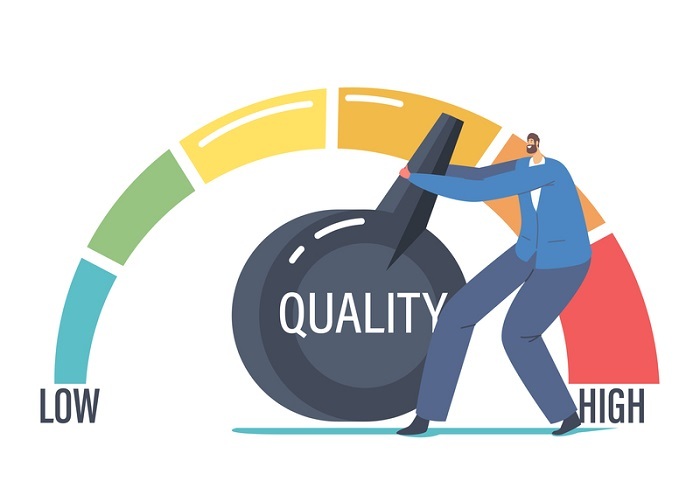
 Data Structure
Data Structure Networking
Networking RDBMS
RDBMS Operating System
Operating System Java
Java MS Excel
MS Excel iOS
iOS HTML
HTML CSS
CSS Android
Android Python
Python C Programming
C Programming C++
C++ C#
C# MongoDB
MongoDB MySQL
MySQL Javascript
Javascript PHP
PHP
- Selected Reading
- UPSC IAS Exams Notes
- Developer's Best Practices
- Questions and Answers
- Effective Resume Writing
- HR Interview Questions
- Computer Glossary
- Who is Who
The Importance of Quality Management
Think of yourself as the owner of a restaurant. You take great pleasure in providing exquisite cuisine and top-notch service, but recently you've seen a drop in client satisfaction. Online reviews from unhappy consumers are on the rise, as are complaints. Even if you're unsure of what's wrong, you must solve it.
Quality management may help in this situation. By implementing quality management techniques, you can ensure that every area of your company ? from the kitchen to the dining room ? performs at its highest level. In this article, we'll look at the numerous advantages of quality management and explain why it's crucial for any company that wants to prosper over the long haul.

What is Quality Management?
Quality management is managing all activities and actions that must be accomplished to maintain a specific level of distinction, such as defining and implementing a quality policy, creating and carrying out quality planning and monitoring, quality control, and quality enhancement.
The term "Quality Management System" is used by employees in quality management (QMS). The defining of company goals and objectives generally precedes the implementation of a QMS at the executive level.
The standard operating procedures (SOPs) used across the company are based on these objectives and goals.
Phases of Quality Management
There are several frameworks and methods for quality management, each with its phases or stages. Nevertheless, the following are the quality management stages that are most often used ?
Planning ? At this stage, firms set quality goals, specify workflows, and pinpoint the resources required to carry them out. Setting quality standards, determining client wants and expectations, and creating methods to satisfy them are all part of the planning process.
Implementation ? Organisations adopt quality management systems and procedures after completing the planning stage. Establishing metrics to gauge high performance necessitates educating staff members, documenting processes, and training personnel.
Evaluation ? At this stage, companies assess and track their quality performance about predetermined parameters. This includes gathering and evaluating data, determining areas for improvement, and putting remedial measures in place to deal with problems.
Improvement ? Companies then change their quality management systems and procedures based on the information gathered during the assessment phase. This can include updating policies, providing personnel with training, or spending money on new tools or technology.
Maintenance ? Organizations must maintain quality management systems and procedures to guarantee continued compliance and continual improvement. This entails frequently assessing and revising processes, keeping an eye on how well they're working, and making improvements as necessary.
Benefits of Quality Management
Increased customer satisfaction
Quality management procedures assist companies in identifying and satisfying the requirements and expectations of their clients. Businesses prioritizing quality can provide goods and services that meet or surpass client expectations. Increased client satisfaction and loyalty may follow from this. Customers happy with their experiences are more inclined to make more purchases, recommend the company to others, and write favorable reviews, which may attract new clients.
Enhanced productivity and efficiency
Quality management procedures assist companies in identifying inefficiencies and wasteful areas within their operations. These problems may be resolved, and firms can become more effective and productive. Businesses may create more with less when more effective, resulting in cost savings and higher profitability. Also, improved delivery times enable enterprises to satisfy client demands.
Cost and waste reduction
Quality management techniques assist companies in identifying and getting rid of waste and inefficiencies. Lean manufacturing techniques, for instance, may cut waste and surplus inventory, which saves money. Businesses may function more profitably and effectively by cutting expenses and waste.
Revenue and profit growth
Quality management may aid companies in several ways to grow their revenue and profit. Businesses may gain and keep consumers by raising the quality of their goods and services. Customers who are happy with the service are more likely to use the company again and recommend it to others, which boosts revenue. Moreover, quality management procedures boost productivity, reduce waste, and lower expenses, promoting profitability.
Enhanced reputation and brand image
Customers and stakeholders have a better impression of a company when quality management is given priority. The whole brand image and reputation of the business may benefit from this. Businesses may stand out from rivals, draw in new clients, and keep their current ones by building a solid reputation.
Standards and Certifications for Quality Management
Certifications and requirements for quality management
Many worldwide standards and certifications are available to assist firms in implementing quality management procedures. Some of the more well-known ones are listed below ?
ISO 9001 ? The ISO 9001 standard for quality management systems is widely accepted. It offers a blueprint for companies to create and implement quality management processes. To be certified, a company must prove that its quality management system complies with the standard's standards.
Total Quality Management (TQM) ? TQM is a management style that focuses on continuous improvement, customer happiness, and staff participation. The quality management process includes all workers; senior management must fully commit to it.
Six Sigma ? Six Sigma is a data-driven quality management strategy to reduce process variance and eliminate flaws. It entails the use of statistical techniques to locate and get rid of process variation causes.
Lean Management ? Lean management is an approach to process improvement that focuses on cutting waste and increasing productivity. It entails locating and getting rid of processes' non-value-added activity.
AS9100 ? The aerospace sector has its version of the AS9100 quality management standard. It is based on ISO 9001 but adds other specifications unique to the aerospace sector.
ISO/TS 16949 ? ISO/TS 16949 is an automotive-specific quality management standard. It offers a structure for creating and putting into practice a quality management system that complies with the standards of the automobile industry.
Challenges in Implementing Quality Manageme
There are many advantages to using quality management methods, but there are also drawbacks. The following are some difficulties companies may have while adopting quality management practices ?
Resistance to change ? Current processes and procedures may need to be changed when implementing quality management methods. Employees who used to do things a certain way may resist this change. Adopting new quality management procedures might be hampered, and the implementation process can be slowed down by resistance to change.
Lack of resources ? Quality management practices implementation may need the addition of employees, equipment, and training. Due to a lack of resources, businesses may find it challenging to adopt quality management principles successfully.
Absence of strong leadership support ? Quality management practices implementation calls for strong leadership support. It might be difficult to successfully adopt quality management methods without the backing of senior management.
Lack of employee participation ? Quality management procedures are most successful when all workers actively participate. It may be difficult to get the intended outcomes if workers are not participating in the quality management process.
Insufficient measurement and analysis ? To discover areas for improvement, quality management procedures need measurement and data analysis. Properly applying quality management principles may be difficult if firms lack the instruments and know-how to monitor and evaluate data.
Difficulty obtaining and keeping certification ? Businesses may have trouble obtaining and retaining certification. Constant commitment and resources are needed to guarantee that quality management techniques are continuously applied and maintained.
Conclusion
Businesses must use quality management to guarantee consistency in their operations, as well as in their goods and services. Customer happiness is crucial in business. Considering a customer's major concern is the quality of the items or services they buy, the supplier's main objective should always be to guarantee that what they provide is consistent and excellent.

